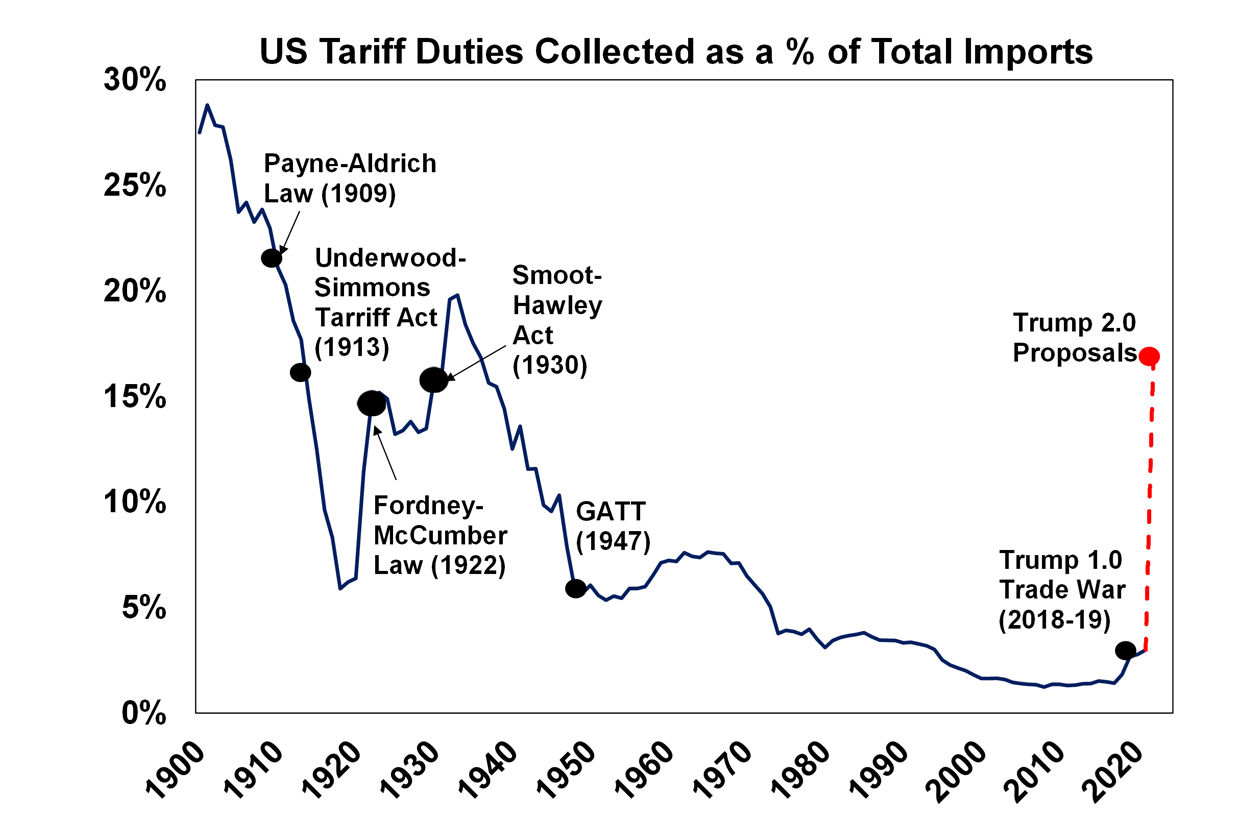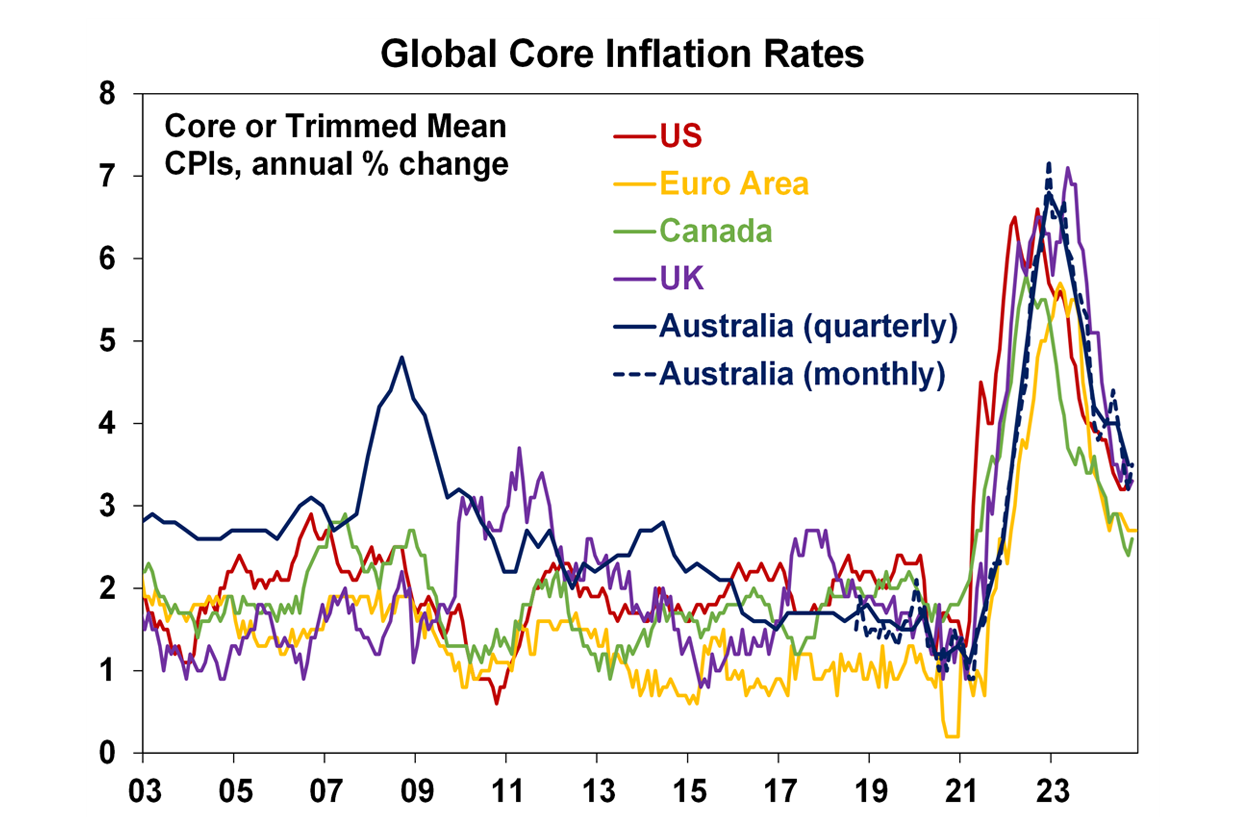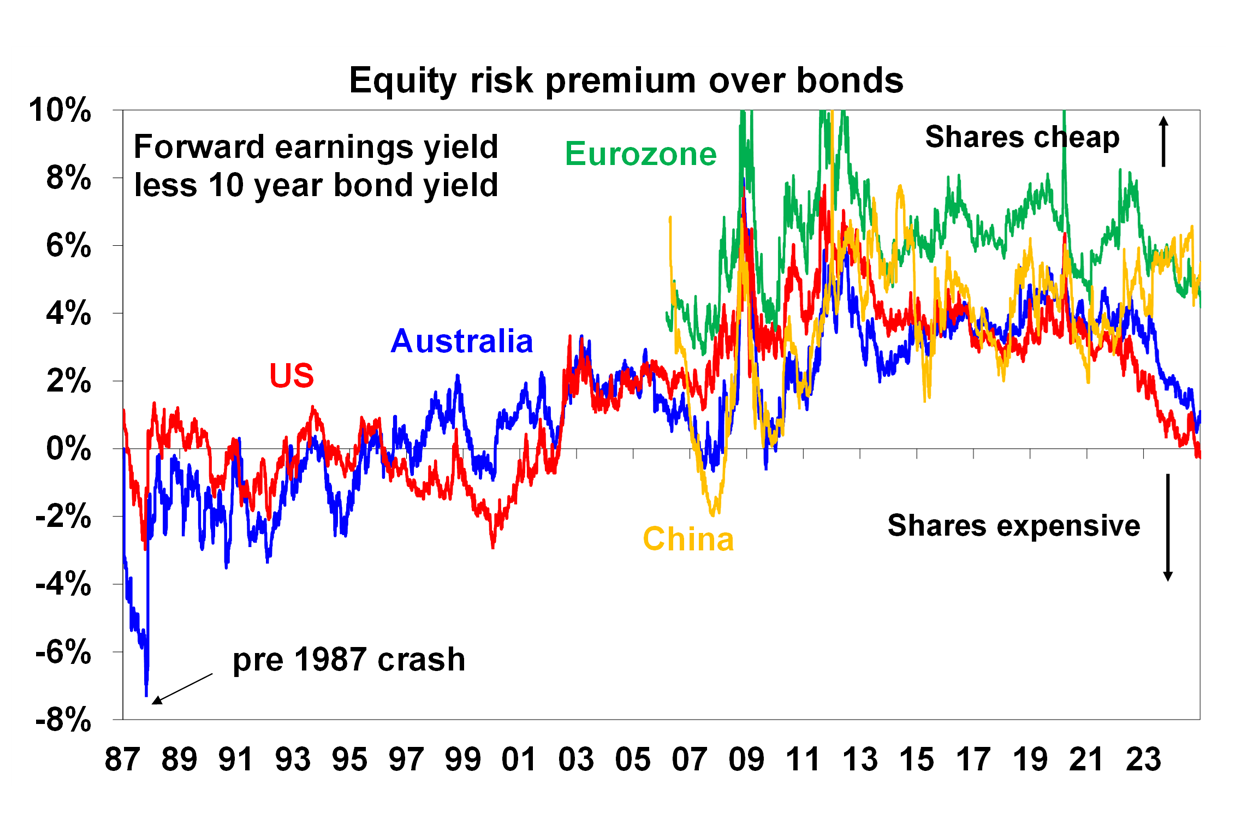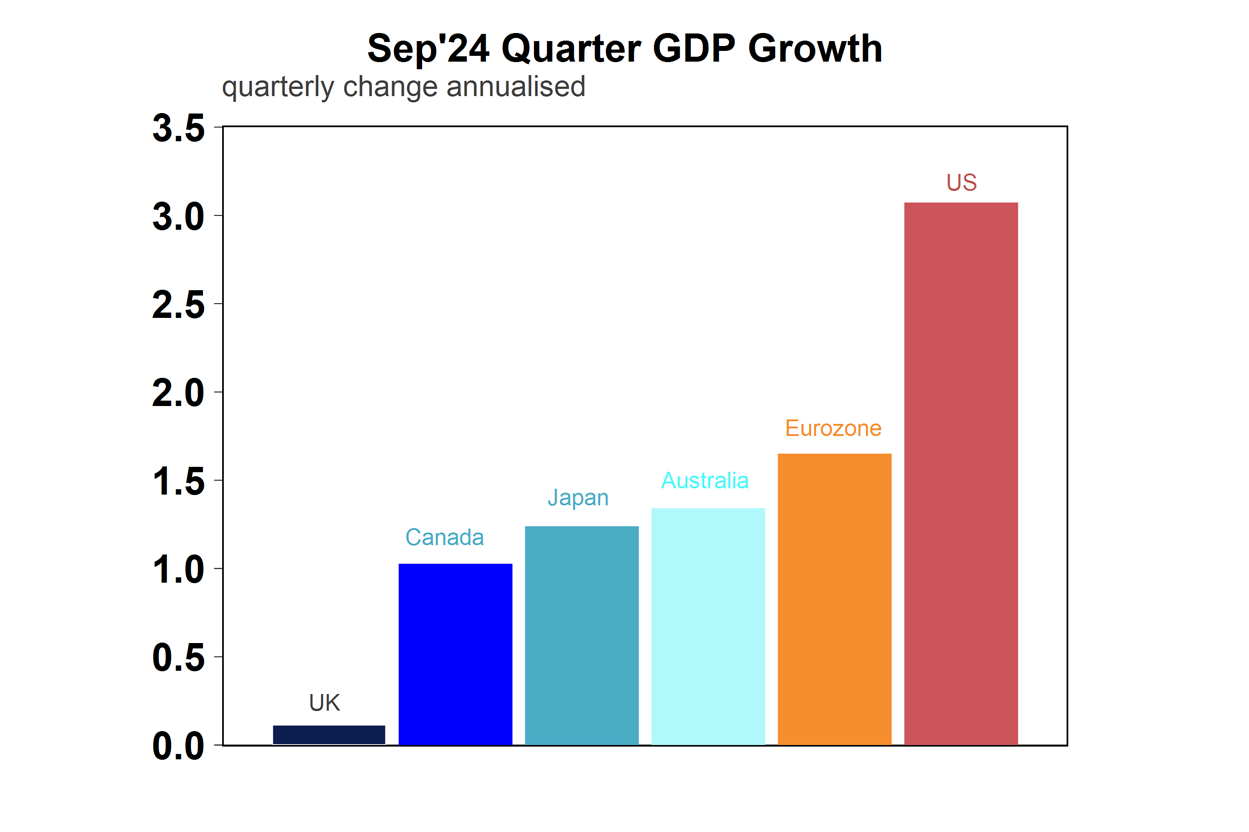Key points
- We have made a “Wishlist” for 2025 of the top 5 things we hope will happen: higher tariffs but not a full-blown global trade war, inflation doesn’t accelerate, bond yields settle back down, global growth broadens out and a simmering in global geopolitical risks.
Introduction
The Econosights team have looked back at the year that was in markets and cast our eye over what the New Year may hold for investors. We have put together a “Wishlist” for 2025 of the top 5 things we hope will happen.
1. US implements higher tariffs on trading partners, but there is no major global trade “war”
It is clear that US tariffs on its global trade partners are going to increase in 2025 with the incoming Trump administration. Trump has already said that he will impose an additional 10% tariff on China and a further 25% on Mexico and Canada as soon as he comes into office. This is not as high as he was threatening in the lead up to the election (talking about a 10-20% general tariff and a further 60% on China) so it’s likely that there will be further announcements on tariffs once the Trump administration starts. The 2018 US trade war with China lead to a 1 percentage point increase in the average US tariff rate from ~1.5% prior to 2018 to 2.7% and has remained at just under 3% as the Biden administration kept most of the Trump tariffs as well as expanding some. Trump’s proposed tariff increases (if fully implemented) would take the average US tariff rate to ~17% - its highest level since the 1930s (see the chart below).

Trade disputes create uncertainty in the economy and financial markets because it is unclear how countries will respond to threats. Usually, countries that have had tariffs imposed on them retaliate with imposing their own tariffs on foreign imports. In 2018, the Trump 1.0 tariffs led to some retaliatory behaviour from major trading partners on US exports, especially on agricultural goods. It is the unknown potential retaliatory measures which tends to be negative for sharemarkets and global growth. The best outcome for the global economy would be if Trump 2.0 tariffs end up being smaller than he has indicated so far, that some are negotiated down and that other countries impose only minor retaliatory measures on US exports.
2. Inflation doesn’t reaccelerate
The pace of inflation slowed noticeably in 2024. The US consumer price index (CPI) started 2024 at 3.1% over the year and was at 2.7% in November. In comparison, Australian headline CPI was running at 3.4%pa in Jan-24 and slowed to 2.3%pa by November. In Canada CPI was at 2.9%pa in Jan-24 and 1.9% by November. New Zealand headline CPI was at 4%pa in early 2024 and 2.2% in the third quarter. And in the Eurozone headline CPI was at 2.8%pa in Jan-24 versus 2.4% in December.
However, this fast pace of disinflation (for headline CPI) has run its course, with headline inflation below 3% on annual basis but is still running above 2% (the level of inflation targeted by most major central banks). The other issue is that core inflation remains higher than central banks would like, at over 3%, although outcomes are mixed across countries (see the chart below).

Goods price inflation has weakened, but food inflation is now starting to pick up and commodity prices have started ticking up again in areas like energy and agriculture. This means that goods price inflation will start ticking up again. This means that if core inflation is to slow further, then services prices need to start easing. There are some positive signs on this. Despite the unemployment rate remaining relatively benign across numerous major economies including the US and Australia, wages growth is still slowing. This is positive for services prices, which are often correlated to wages growth. Other large weighed items like housing-related inflation is also likely to soften based on new asking rents in the US and Australia.
We expect core Inflation to slow in 2025, below 3% per annum. However, given recent upside inflation surprises and the high likelihood of higher tariffs, it is difficult to see headline inflation slowing to 2% for now. So, a good outcome for 2025 would be no further acceleration in inflation from current levels, which would help consumer purchasing power and the recent cost-of-living challenges faced by households.
3. Bond yields settle back down
There has been a considerable lift to US bond yields since September 2024, with a noticeable leg up from early December. Moves in US bond yields tend to flow through to other markets. The rise in yields reflects a reassessment by markets about the number of US rate cuts likely in 2025, after the Fed’s “hawkish” December rate cut. The Fed’s own “dot plot” (a summary of the Fed members projections for interest rates) suggests at least 2 further rate cuts in 2025. Though, strong US jobs data for December has seen financial markets now pricing in just one rate cut this year. Yields have also risen on expectations of higher inflation from Trump 2.0 tariffs when the new administration starts. The lift in bond yields has probably gone too far, given our view that core inflation has further room to decline and because the risk to growth is to the downside. Higher bond yields threaten the outlook for equities from a valuation point of view. The risk premium (calculated by subtracting the 10-year bond yield from the earnings yield) is negative in the US and sub 1% for Australia (see the next chart). We expect that US 10-year yields will decline back towards 4% later this year.

4. Global growth broadens out
The US has been an exceptional outperformer in the last two years, in respect to economic growth and sharemarket returns. The global economy looks to have expanded by 3.2% in 2024 and we expect growth of around 3% this year, which is around its long-run average. US GDP growth looks to have ended 2024 up by 2.6%. This is much stronger compared to its peers including Australia (1.0%), Eurozone (1.3%), Japan (0.4%) and the UK (1.6%). GDP growth is higher in China (at ~5% last year) but this is because emerging market GDP growth always tends to run above advanced economies.
Better growth outcomes across the rest of the world outside of the US could result from a pick up in the Eurozone (which has been skirting around a recession in the last two years) and in China which are both important trade partners for many large south-east Asian economies like India, Indonesia, Thailand, Korea and Vietnam.
A broadening out of economic growth across other major advanced economies would help to put downward pressure on the US dollar, which is positive for emerging markets because emerging market debt is priced in US dollars. A lower USD also encourages investment outside of the US.

5. A simmering in global geopolitical risks
From a humanitarian point of view, the resolution in major conflict conflicts between Russia/Ukraine and Israel/Hamas (which now involves Iran and Lebanon) would be very welcome. From a markets point of view, global conflicts and the threat of further escalation increase geopolitical risk. One way to measure changes in geopolitical events is through a “Geopolitical Risk Index” which was constructed by Dario Caldara and Matteo Iacoviello based on a tally of newspaper articles. The chart below highlights the events that caused the largest spikes in the index. Newspaper articles are searched for words that include citations of war threats, peace threats, military buildups, nuclear threats, terror threats, beginning of war, escalation of war and terror acts. The trend in recent years has been an uptrend in the geopolitical risk index, which makes sense given the current environment we are living in.

While its clear that geopolitical threats and risks remain, the impact to the Australian economy and global markets is more nuanced. Some events can cause initial large falls in sharemarkets, but a year after the event markets have tended to be higher, which shows that sharemarkets eventually recover from the initial shock.
But in the short-term, less geopolitical risks would be welcome for markets, as it will reduce volatility and uncertainty.
Diana Mousina, Deputy Chief Economist, AMP
Important note
While every care has been taken in the preparation of this document, neither National Mutual Funds Management Ltd (ABN 32 006 787 720, AFSL 234652) (NMFM), AMP Limited ABN 49 079 354 519 nor any other member of the AMP Group (AMP) makes any representations or warranties as to the accuracy or completeness of any statement in it including, without limitation, any forecasts. Past performance is not a reliable indicator of future performance.
This document has been prepared for the purpose of providing general information, without taking account of any particular investor’s objectives, financial situation or needs. An investor should, before making any investment decisions, consider the appropriateness of the information in this document, and seek professional advice, having regard to the investor’s objectives, financial situation and needs. This document is solely for the use of the party to whom it is provided.
This document is not intended for distribution or use in any jurisdiction where it would be contrary to applicable laws, regulations or directives and does not constitute a recommendation, offer, solicitation or invitation to invest.








